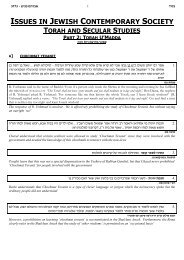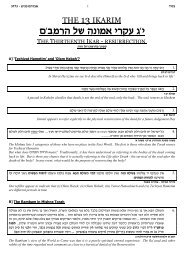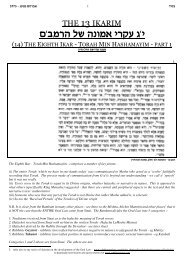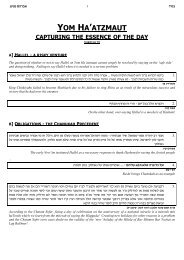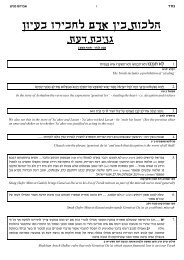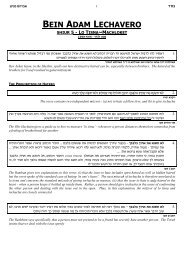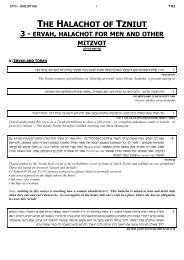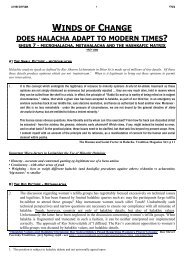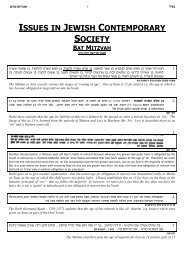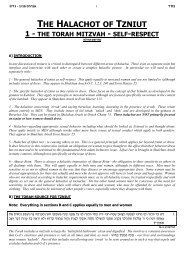You also want an ePaper? Increase the reach of your titles
YUMPU automatically turns print PDFs into web optimized ePapers that Google loves.
dbhbn ovrct1sxcDA’AT TORAH ANDRABBINIC AUTHORITYSHIUR 2 - LO TASUR - THE ROOT OF RABBINIC AUTHORITYdga, ;ruj - rsbk iufn1. The Sages said that [we must obey the Beit Din] even when they say that ‘left’ is ‘right’. [One should] not say(perish the thought) that [the dayanim] erred because ‘I, the puny one, see clearly that they have erred.’Rather, one’s own perception must be nullified before the brilliance of their intelligence and their siyatadeshemaya. The Sages have said “One Sanhedrin cannot nullify [a ruling by] an [earlier] Sanhedrin unless it isgreater in wisdom and number.” ... This is the Torah view [da’at Torah] on emunas chachamim.Rav Eliyahu Dessler, Michtav Me’Eliyahu I p75We saw in the first shiur that Rav Dessler clearly invokes the mitzvah of <strong>Lo</strong> <strong>Tasur</strong> and the authority of the Sanhedrin toexplain the binding nature of Da’at Torah. This is perhaps that most used source for the concept and will be analyzed inthis shiurA] THE SANHEDRINs ºgIn k v«´tk t Æo ,«t ³T j ek u uh· r y« J u o g v h¬b ez o²vh F T g ºsh r´Jt ķ t rGh h´b e Z n »Jh t oh´ g c J hº Kvp xt v ÀJ«nk t v r nt«Ḩu zy 2.t¬¬ ,t «k u o ºg v t´¬ n C ÆW T t U ³t Gb u o·vhkg h´T n G u Whkg r¬Jt jU r²vi n h ÀTkmt u ¸o J »W N g h´T rC su h ÀT srh u zh :QN g oJ U¬c Mh , v uWS ck vT tzh-zy:th rcsncThe original Beit Din HaGadol (which later became known as the Sanhedrin) of 70 elders plus Moshe was established inorder to ease the burden on Moshe. The verses refer explicitly to part of Moshe’s ‘ruach hakodesh’ resting on themok JUrh Uc JHu chrk u wv y P J nk k t rGhk ,«uc t v h Jt rnU ohbv«F v u oH uk v i n yp J«uvh sh ng v ok JUrh C od u 3.j euxp yh erp c ohnhv hrcsThe Sanhedrin functioned throughout Jewish history, including throughout the First and Second Temple periods and wasbased in the Temple complex. 40 years prior to the destruction of the Second Temple, the Sanhedrin left its home andbegan a period of exile, first within Jerusalem and then, following the Churban, to other parts of Eretz Yisrael. It movedfirst to Yavneh, then Usha, back to Yavneh, again to Usha, to Shefaram, Beth Shearim, Sephoris and finally, in around200 CE to Tiberias. Its power waned over the subsequent years under increasing pressure from the Roman Byzantineauthorities until it was eventually made illegal by the Romans in 425 CE 1B] THE SOURCE OF RABBINIC AUTHORITY - THE SANHEDRINr¬Jt oI ºe N vk¸t ,h kg º u ´T n e u Wh·rg J C ,«ch r h¬ r c S gdºbk Ægd¸b ih¬cU ihsk À ih´ SihC o ¹sk o¸SihC y ÀP J Nk r ¹c s ÆW N n ÁtkPh h´F j:yP J N v r¬c S ,t ºWk Ush´D v u ÆT J rs u o·v v oh´nH C vh vh r¬Jt y ºp« vk¸t u oºH ukv Æohbv«F vk t À,tcU y :I C Whv«kt v r²j chrJt v rIT v hPkgth :WU rIh rJt k«f F ,I Ggk º T r nJ u v r j ch rJt tU ºv v oI e N vi n ºWk UshDh rJt rc S v hPkg ,h Gg u hiI Àsz c v´Gghr Jt Jh ºt v u ch :kt« n GU ihnh Wk UshDhr Jt rc S vi n rU x, t«k v·GgT Wk Ur nt«hr Jt yP J N vkg u WU rIho g vkf u dh :kt rGH n g r v ¬T rgcU tU ºv v Jh´t v Æ, nU y·p« vk t I t Whe«kt v, t Æo J , r³Jk s ºn«gv Æi v«F vk t g«³n J h¸Tk cksI g iUshzh t¬«k u Ut· rh u Uǵ n Jhdh-j:zh ohrcsThe Torah here vests authority in ‘the <strong>Rabbi</strong>s’. Important questions on this include:-(i) Which <strong>Rabbi</strong>s does this include? Only the Sanhedrin in the Temple complex? The Sanhedrin even in exile? ‘Chazal’ -the rabbis of the Talmudic period? Contemporary rabbis?4.1. For a good summary of the history of the Sanhedrin and attempts in modern times to re-establish it, seewww.thesanhedrin.org/en/index.php?title=Historical_Overview
dbhbn ovrct2sxc(ii) What areas of halachic life fall within this authority? According to some commentators, the authority is broad - toengage in the the process of (i) transmission (mesorah); (ii) interpretation (drasha) and (iii) legislation (mitzvotderabbanan). Others interpret the authority more narrowly(iii) Does this authority extend beyond the realm of halacha and if so how far? Issues of hashkafa? Totally non-religiousmatters?(iv) How does this authority interface with other related concepts such as Da’at Torah, Emunat Chachamim?ktna ktna kgu ihnh ihnh kg lk rnuta ifa kfu 'ihnh tuva ktna kgu ktna tuva ihnh kg lk rnut ukhpt - ktnau ihnh (th) 5.th:zh ohrcs h"arThis famous Rashi paraphrases Chazal who state that ‘left’ and ‘right’ means even if the Sanhedrin tell us to dosomething which seems clearly wrong, we must listenovk gna ihnh tuva ktna kgu ktna tuva ihnh kg lhbhgc ohtrn ukhpt 'ktnau ihnh 6.sbe texhp ohypua ,arp ohrcs hrpxThe actual source in Chazal says that even is ‘it seems to us’ that the answer is wrong, implying that if it is obviouslywrong then we need not listen- wktnau ihnh ,fkkw rnuk sunk, ?!ovk gna, ihnh thva ktna kgu ktna thva ihnh kg lk urnth ot kufh hb,s 7.ktna thva ktna kgu ihnh tuva ihnh kg lk urnthat"vq s ruy vn ;s t erp ,uhruv ,fxn hnkaurh sunk,The Talmud Yerushalmi clearly understands these verses to mean that, a scholar may NOT follow the ruling of theSanhedrin when he is convinced that it is in fact so clearly in error that they have mixed up ‘left and right’. This ruling isin fact following in the Bavli (Harayot 2b) and is stated in the Rambamk v E v hbhg n (r,un tuva vru,ca ,u,hrf kfn ,jtc ,uruvk ugy) rc S ok gb u UD Jh (ihrsvbx ukt) k t rGh , sg kF o t u (dh) 8.Uchre v u vhkg Ut y j r Jt ,t Y j v vg s«ub u (sh) :Un J t u vbh Gg , t«k r Jt wv ,«u m n kF n , j t (ovhp kg rucm uaga) UGg u, t y j J u wv hb pk rP v Jt«r kg o vh sh , t v sg v hb ez Uf n x u (uy) :sg«un k v«t hb pk «u,«t Uth c v u ,t Y jk r eC iC r P k v E vwv hb pk rP v(h"aru) s erp trehuThe Chumash includes a procedure for when the Sanhedrin issues a mistaken psak and the community follows itkg vkug vhva 'i,truv hbpn ukftu ruxt vchev ckjau ugya kvev in sjt gshu 'ukuf vchev ckj kuftk ihs ,hc uruv 9.ihbnk ;rymn ubhtu 'u,khft kg vguce ,tyj chhj kfutv vz hrv 'ohguy ova p"gt ihs ,hcn gunak vumna i,gshrv .rtv og vhv ot kct vtruvk ghdva shnk, ut ofj ugya gsha vz vhvaf ohrunt ohrcs vnc /ovhp kg ohdduav,htsu vghsh ihruxhtc u,ghsh ihta ruyp vzv vfkv dh erp ,udda ,ufkv o"cnrIf a talmid chacham followed the mistaken psak of the Sanhedrin in the knowledge that it was wrong, he must bring hisown korban. He should have known better than to follow a mistaken psak!It clearly follows that (a) the <strong>Rabbi</strong>s are not infallible and (b) we my not follow them if it is clear that they are wrong.This clearly seems to conflict with the Sifri on ‘left and right’! The Rishonim and Acharonim were well aware of the sitraand there are many approaches to reconcile the two 2 .One approach to reconciliation is to note that the Sanhedrin had full authority only once it had formally taken a vote andissued a psak. Without this formal process the concept of ‘left and right’ does not apply. However, others take the viewthat there is a fundamental dispute here in Chazal as to the authority of the Sanhedrin, with the Yerushalmi (and theRambam) ruling that such authority is NOT absolute in the face of an obvious error 32. See Kaplan 1992 pp29-33 for a summary of some of the commentaries3. See Rav Dovid Zvi Hoffman in Melamed LeHo’il 3:82 who understands that the two sources differ as to the exegesis of the Devarim 17:11 -,ruxnk ot ah ut trenk ot ah
dbhbn ovrct3sxcAs noted above, a careful look at Rashi will show that he actually strengthened the language of the Sifri to state that evenif the Beit Din tell us DIRECTLY something which seems obviously wrong, we still have to follow it. The Ramban onChumash explains why this iscuaj, ukhpt 'ubhbgu /h"ar iuak 'ihnh tuva ktna kg ut ktna tuva ihnh kg lk rnut ot ukhpt - ktnau ihnh (th) 10.ckjv kfut lht rnt, ktu 'o,umnf vag, 'lktnak lbhnh ihc gsuh v,t ratf lhbhgc yuap rcsvu 'ohguy ova lckcrat kff uh,umn kfc vagta ,umnv kg vumnv iustv h,ut vum lf rnt, kct 'vzv hebv ahtv durvt ut vzv rundvouhc d"r og gauvh hcr ihbgf vzu 'ugyh ukhpt vru,v hk i,b o,gs ,ugnan kgu rjch rat ouenc uhbpk ohsnugv hburuh:(/vf v"r) ubucajc ,uhvk kja ohruphfvucrh vbvu 'ohskubv ohrcsv kfc ,ugsv uu,ah tka tuv gushu 'c,fc ubk vb,b vru,v hf 'stn kusd ,tzv vumnc lrumvurjch rat ouenc oav hbpk snugv kusdv ihs ,hck gnaba 'ihsv cu,fv ubk l,ju /,uru, vnf vru,v vag,u ,ueukjnvtrenv ,ugnan hpk if urntha ut 'vrucdv hpn vanu sg hpn sg uaurhp ukcea ihc 'vru,v aurhpc ubk urntha vn kfclk aha ifa kfu 'ktnac ihnhv ;hkjnf lhbhgc vhvh ukhpt 'vru,v [ovk] (ubk) i,ub tuv ovka ,gsv kg hf 'v,buuf ut,ugyv in urnab okugk uhshxj ,t cuzgh tku uasen h,ran kg oav jur hf 'ihnh tuva ihnh kg ohrnut ova cuajkovk gna ihnh tuva ktna kgu ktna tuva ihnhv kg lhbhgc ihtrn ukhpt (sbe ohypua) hrpx iuaku /kuafnv inuth euxp zh erp ohrcs i"cnrAccording to the Ramban, the Sanhedrin is protected from mistake by Divine assistance and, even if they DO makemistakes, we are obligated to follow the ruling 4lthv iv rea hsg xbhfrv ic txus hcr rnt kthknd icr ikceu vtrb tk urucg khkcu ubnzc uvubhtr urntu ohba utc sugu 11.hbrzud kthknd icr uk jka [y] /lhrcs ,t hbt vtur gauvh wr uk rnt vhbha ihc vxhrf rjnku vskha vatv kg ohshgnhk ah uk rnt rmhn tcheg hcr utmnu lkv /lbucajc ,uhvk kja ohrupfv ouhc lh,ugncu lkenc hkmt tc,a lhkgihc ibnzc ihc - o,t utre, rat asue htren wv hsgun vkt (df trehu) rntba huag kthknd icr vaga vn kfa sunkkicr ka ubhs ,hc rjt iusk ubt ihtc ot uk rnt /xbhfrv ic txus hcr kmt uk tc /ukt tkt ,usgun hk iht ibnzc tkacsb irvtu van kghu (sf ,una) rntba uhafg sgu van ,unhn snga ihs ,hcu ihs ,hc kf rjt iusk ubt ihfhrm kthkndkg ihs ,hc usnga vakau vaka kfa snkk tkt ohbez ka i,una uarp,b tk vnku /ktrah hbezn ohgcau tuvhctu,uhvk ohrupfv ouh kja ouhc kthknd icr kmt vbchk lkvu ushc uh,ugnu uken kyb /van ka ubhs ,hcf tuv hrv ktrahhrcs ,kcea hshnk,u vnfjc hcr hshnk,u hcr oukac tuc uk rnt uatr kg ueabu kthknd icr sng /ubucajcy-j vban c erp vbav atr ,fxn vban<strong>Rabbi</strong> Yehoshua was forced to comply with the psak of Rabban Gamliel, even though he was convinced it was wronglcren thcb hsh kgu van hsh kg of,t h,huma vn kg 'of,t vumn hfbt rat rcsv kg uphxu, tk (c:s ohrcs) urntn vhvu 12.ohrzgb ova hbpn /wv rjch rat ouenv in ohypuavu ohbvfv uhkg umceba vnu 'vtucbc ohrfzbv ohtb,v kg 'lhjtno,nfjk ,ugyv ovhkg rucg, tku /ocur rucgc 'vru,v kg ekuja rcsc unhfxha ovhkg rucgk if,h tku 'vbhfacvek,xba ygna ifa kf ',unfjv kf ,gsk ohuumn uhv ihrsvbxv hf 'ukce ratf /vhubev ,hgcyvu vaurhv vcjrvvz ,kuzu kue ,cn vnuenc snuga vn ut vtucbv ovntn ,ut d rntn hrzufv rpxThe Kuzari also states that the collective Sanhedrin were protected from mistake due to their number and their verybroad wisdom'o,umnn rux, tk ihnh tuva ktna kgu ktna tuva ihnh kg lk urnth ukhpt 'ktnau ihnh ubnn rux, tk [itf hrpx] 13.,ugy kucxk cuyu 'o,ugyf vagb kct ovhkg eukjk ubk hutr iht ohrcsv in sjt rcsc ohguy ov uhvh ukhpta rnukfck eukju ,sv icruj vhvh vzca u,gs hpf sjtu sjt kf vagha tku 'shn, cuyv o,gs ,j, ohruxn kfv uhvhu sjtktrah hnfj kt vru,v ,buuf vrxnb vkt ohbhbg hbpnu /hrndk vnutv sxpvu ogvum, vumn lubhjv rpxThe Chinuch fully accepts the possibility of the Sanhedrin making a mistake but we must still follow them. That is a priceworth paying for a unified religious practiceWe now need to analyze whether any of the statements made above concerning the Sanhedrin can inform our modernunderstanding of Da’at Torah4. Note that different commentators have debated the import of these words of the Ramban. Do they imply that there IS an objective truth 'inShamayim’ but G-d does not require of us to find it - thv ohnac tk. Rather the ruling of the majority of the most qualified people - theSanhedrin - is the best that we can humanly do (see Derashot HaRan #11). Or, is the Ramban telling us that there is actually no ‘objective’ truth‘out there’. The ‘real’ truth is whatever the Sanhedrin determines it to be.
dbhbn ovrct4sxcC] WHICH RABBIS HAVE THE AUTHORITY OF THE SANHEDRIN?C1] THE POSITION OF THE RAMBAM//// r,hvu ruxhtn uc uumha vn kf ,uagku kusdv ihs ,hck gunak ubuma thv s"gev vumnvu 14.sge vag ,umn o"cnrk ,uumnv rpxThe Rambam explains that the positive mitzvah is to listen to the ‘Beit Din HaGadol’tk urnt tuvu /vru,v vagnc o,uumnn ,tmnu oukav ovhkg vkcev hkgc kg eukjn ubrhvzva thv c"hav vumnvu 15.lk ushdh rat rcsv in rux,cha vag, tk ,umn o"cnrk ,uumnv rpxBut the negative mitzvah is not to deviate from the words of the ‘Ba’alei Hakabala’. This expression would seem toinclude <strong>Rabbi</strong>s after the Sanhedrin ....vp kgca vru, oheh,gnv ktrah hnfj hkusd ;ux ovhrcju hat cru tbhcr tmnb 16.o"cnrk vezjv shk vnsev.... but only until the time of Ravina and Rav Ashi who put together the Gemara. Thus according to the Sefer Hamitzvotthe authority of the Talmud may be rooted in <strong>Lo</strong> <strong>Tasur</strong>ausev ubhcr ,unhn ihs ,hcu ihs ,hc kfc uasj,ba ohrcsu vh,ueng ruthcu ,uhbanv hrcs aurhp tuv ,urndv hba ihbgu 17.u,ut ka ihs ,hc utra unf rusu rus kfc udvba ut ubhe,va ,ube,vu ,udvbnv ovn rtc,h ifu///// /trndv ruchj sguktnau ihnh lk ushdh rat rcsv in rux, tk rntba ovn ruxk ruxta hpk /rusvo"cnrk vezjv shk vnsevThe Rambam also indicates in the introduction to the Yad that the <strong>Lo</strong> <strong>Tasur</strong> applies up until the end of the Gemaraivhkgu 'ktrah kfk tmuh ypanu ej ovnu vtruvv hsung ovu 'vp kgca vru, rehg ov ohkaurhca kusdv ihs ,hc 18.,sv vagn lunxk chhj u,ru,cu ubhcr vanc ihntnv kfu 'vag ,umn uz luruh rat vru,v hp kg rntba vru, vjhycvivhkg igahku ivhkgohrcs sjt ////// ktnau ihnh lk ushdh rat rcsv kfn rux, tk rntba vag, tkc rcug i,truvf vaug ubhta hn kf civc ,arsb vru,va ,usnv in ,jtc o,gs hpn ousnka ohrcs sjtu 'vp kgca vru, ovu vgunav hpn i,ut usnka,ube,vu ,urzdv ivu vfhrm vgava vn hpku vru,k dhhx outaga ohrcs sjtu 'tuv lf vz rcsa ovhbhgc vtrbutuv hrv /vag, tkc rcug ivn sjt kf kg rcugvu 'ivk gunak vag ,umn ohrcs vakav uktn sjtu sjt kf /,udvbnvukgu /okugv ie,ku ,sv ezjk hsf ohcrk ovc uruha ,udvbnvu ,urhzdvu ,ube,v ukt - luruh rat vru,v hp kg :rnut- lk ushdh rat rcsv kfn /ivc ,arsb vru,va ,usnv in ,jtc ihsv in i,ut usnkha ohrcs ukt - urnth rat ypanv/aht hpn aht ukcea vkcev uzt erp ohrnn ,ufkv o"cnrIn the Mishne Torah itself however, the Rambam explains that BOTH the positive and negative mitzvot of <strong>Lo</strong> <strong>Tasur</strong> relateonly to the Sanhedrin. The Rambam also states that the authority of <strong>Lo</strong> <strong>Tasur</strong> extends to all three areas of halachicmaterial:- (a) Halacha LeMoshe MiSinai; (b) Halachot derived from Chumash through drash; (c) <strong>Rabbi</strong>nic legislationt///// v,hn uk orud ouenva snkn ouenv kt ,hkgu ,neu rntba 'ruyp ivhkg vrnvu inuenk .uj itmn18.z vfkv d erp ohrnn ,ufkv o"cnrouenv in vkusd hrsvbx v,kdan kct ///// ,hzdv ,fakc vnuenc vkusd hrsvbxa inz kf rnukf /orud ouenva snkn //// 19.onuenc uhvha sg ovn o,uaru ojuf kyb ruzjku ygn khhyk oan o,thmhc ukhptu /ktrah kfn ,uapb hbhs ukyc tuvvsnkn ouenv kt ,hkgu ,neu k", vtrnv u,trnv tv, kufh 'ivhkg vrnvu hdtp ,hct itmn (:sh wvbx) urnta unfypan ah ivf vhvha inzc - ypuav ktu ohukv ohbvfv kt ,tcu //// urnta unf icruj rjtk ifa kfu /orud ouenvavga v,utnu /wufu ,unk ubje, hjczn ogn k", jcznk vfunx vkusd hrsvbx tv,a ihbnu///// ypan iht ivf ihta inzckusdv s"cc ihhuk,v ihbhsv kf ukycdbe vag ,umn ,uumnv rpxk i"cnrv ,udav
dbhbn ovrct5sxcFurthermore, the Sanhedrin means ONLY the body that sat in its authorized place in the Beit Mikdash. The clearimplication is that once the Sanhedrin moved away from the Temple, <strong>Lo</strong> <strong>Tasur</strong> no longer appliesvbchca ihs ,hc ,ucrk -À,t cU 20.dbe texhp ohypua ,arp ohrcs hrpxChazal elsewhere indicate that the Sanhedrin has the authority of <strong>Lo</strong> <strong>Tasur</strong> EVEN when exiled to Yavneh. The TalmudYerushalmi also brings such a opinioniht 'ktrah kfc o,be,u o,urzd vyapa pwgt ',hzdv ,fakk .uj ohkaurhca kusdv swc urzd ukhpts uhrcsk ;hxun hbbvu 21.thv tnkgc t,fnxt tkt vru,v inrux, tks utk tku luruh rat vru,v hp kgs vag tk odvbnu o,be, kfcv:t arua ,umv rpx tcy t,hbdrnR’ Aryeh Leib Horowitz rules that any ruling made by the Sanhedrin once outside its original place has the authority of<strong>Lo</strong> <strong>Tasur</strong> only on a rabbinic levellt /,uyvk ohcr hrjt urntc kkfb uvzu 'vru,v hbhsc urtcha vnc gunak ubhuymb ovhrjt ohtcv ,urusv hnfjku 22.rjt vru,v hypan ruthcc lkba er 'kukfh tk vza ',uyvk ohcr hrjtn ovn ubhuymb tk uagha ,ube,vu ohrsdvchrun o,uhvk ihrsvbxk jfv vz i,ba unfa 'rux, tk kt oufhnxv kct 'kkf ohdhhxu ohrsd vzv kkfc uxbfh tku 'curvtk kt ,ube,vu ohrsdv uxjhh vzv ogyv inu /t,fnxtv lrsc ktrah hkusd hnfj kfk i,bha hutr if 'vhkusdu vru,v,uyvk ohcr hrjtn ovhrcs gunak cuhjv vhvh vru,v hypan ruthcc lt 'rux,rag ohbav aursv i"rv ,uarsThe Ran understands that <strong>Lo</strong> <strong>Tasur</strong> applies on a <strong>Rabbi</strong>nic level to the generations of gedolim that come after theSanhedrin (perhaps even today?)If <strong>Lo</strong> <strong>Tasur</strong> on a Torah level is restricted to the Sanhedrin (either in the Temple or in exile), wherein lies the authority ofthe Talmud, which was completed centuries after the Sanhedrin was disbanded?,udvbnv kfc duvbk vbhsnu vbhsn kfu rhgu rhg kf ihpufu ovc ,fkk ktrah kf ihchhj hkccv trndca ohrcsv kf kct 23.ktrah kf ovhkg unhfxv trndca ohrcsv o,ut kfu khtuv /o,ube,c ,fkku o,urhzd ruzdku trndv hnfj udvbao"cnrk vezjv shk vnsevThe Rambam explains that the authority of the Talmud is based on the universal acceptance of Klal Yisraeluyap tk ,ucr ,ubhsn hbck ut u,bhsn hbck dhvbv ut ihe,v ut rzdu vbhsnu vbhsn kfc trndv rjt snga ihs ,hc kf 24.ka kusdv ihs ,hcu ohshjh vbhsnv v,ut ka ihs ,hc ,uhvu /ohfrsv aucau ovh,ucaun eujr hbpn ktrah kfc uhagnihtu /,rjtv vbhsn dvbnf duvbk uz vbhsn habt ihpuf iht lfhpk /trndv ruchj osue ohba vnfn kyc sjtu ohgcartc,bu tuv lf ypanv lrsa ohbutdvn sjt snk ot ifu /u,bhsnc rjt ihs ,hc vrzda vrhzd ruzdk vz ihs ,hck ohrnutihc uhrcsk vyub ,gsva hnk tkt iuatrk ihgnua iht 'trndc cu,fv ypanv lrs vz ihta uhrjt snga rjt ihs ,hckiurjt ihc iuatro"cnrk vezjv shk vnsevThe Rambam here states that <strong>Rabbi</strong>s after the Gemara (c500 CE) have only local authority over those communities whichaccept themvn,jba ouhna wndv ,nh,jc od uag ifu ohbuatrv kg uekjh tk ohburjtv ,urusa ukceu unhhe vbanv ,nh,j ouhna 25.vhkg eukjk ost ouak ,uar i,hb tkt vfkv c erp ohrnn ,ufkv vban ;xfThis is also how the Kesef Mishne understands the Rambam. After the Sanhedrin, <strong>Rabbi</strong>nic authority is based oncommunal acceptance. Thus the Mishna and the Gemara achieved their standing through this acceptanceR. Chaim Brisker explained the Rambam to mean that any Beit Din that is accepted by all of Klal Yisrael has the status ofa Sanhedrin and its psak is binding. (Due to To <strong>Tasur</strong>?). Rav Elchanan Wasserman also held that a universally acceptedstatement of the Gedolei Yisrael even today had the status of the Beit Din Hagadol
dbhbn ovrct6sxcThis position of the Rambam was tested strongly in his dispute with the Gaon Rav Shmuel ben Eli who headed theAcademy in Bavel from around 1160-1200. Some salient points on that episode:-• Shmuel b. Eli claimed a genealogy back to Shmuel HaNavi and ran a grand palatial court. Every Jew in Bavel wasrequired to contribute to his financial treasury• SbE claimed that the Geonate in Bavel were the successors to the Sanhedrin and wielded its authority - a point whichthe Rambam pointedly denied - see above• Rambam criticized SbE’s coercive style, and the hierarchical leadership of the Geonate and the heavy emphasis onstudy of Talmud to the exclusion of other things• SbE attacked the Rambam in a polemical work, to which the Rambam responded in his Ma’amar Techiyat Hametim• Rambam intervened in supporting the appointment of the Reish Galuta in Bavel which also angered SbE who actuallyopposed the institution of the Exilarch generally and felt that leadership should rest only in the hands of the Geonim 5C2] THE POSITION OF THE SEFER HACHINUCHif od vumnv kkfcu /uruh rat kf ,uagk ihuumn kfva ',ucebu ohrfzc okaurhc kusdv ihs ,hca inzc uz vumn ,dvubu 26.atr) vfrck oburfz uarsa unfu /ubbnzc ubhbhc vhvh rat kusdv ofjv rnukf 'ypuav ,umnf inzu inz kfc ,uagku gunakurusc j,ph kuec gunak ubhkg vumna rnukf /urusc ktunaf urusc j,ph - ovv ohnhc vhvh rat ypuav ktu (:vf vbavuabgu /vz vag kycn uruh rat kfc vru,v ,nfjc rusca ohkusdv ,mgk gnua ubhtu vz kg rcugu /urusc ktunak unf,gs uc aha hn kfk rcsv gush 'uc ,bgab vru,va ezjv sungv uvza stn kusdvm, vumn lubhjv rpxThe Sefer HaChinuch agrees with the Rambam that the Mitzvah of <strong>Lo</strong> <strong>Tasur</strong> applies to all aspects of <strong>Rabbi</strong>nic Law - seeabove. He goes further however to say that the mitzvah of <strong>Lo</strong> <strong>Tasur</strong> applies even to the <strong>Rabbi</strong>s of our generation. Thisis based on the Chazal that Yiftach must be respected in his generation like Shmuel in hiskfcu ouen kfc ,dvub ubrusca ubhypuau vru,v ,nfjc ubhkusd ktu ohbunsev ubhnfj hrcsk gunak ubhkg cuhjv ihbgku 27.,ucebu ohrfzc inzum, vumn lubhjv rpxHe also reiterates this for the positive Torah mitzvah to listen to the Gedolim - this applies to the Gedolim today28.um, vumn lubhjv ,jbnThe classic commentary on the Sefer Hachinuch - the Minchat Chinuch (19C Russia) - asks where the Sefer Hachinuchcould have obtained such a psak. He suggests that there may be indications of this in the Rambam or Ramban (mostother commentators disagree) and ends by stating that the Sefer Hachinuch must have got it from somewhere!!! 6 29.rux, tk ch,fs t,hhruts utkc ,ubak ruxt hzt 'vru,k rsdu dhhx uagk ubhbnzca ohbutdv whpt ut k"zj ube,a rcs kctt ;hgx zfe kkf (ohsgunu ,ca ,ufkv) d-c ekj ost hhjThe Chayai Adam rules like the Chinuch - all rulings by contemporary <strong>Rabbi</strong>s to ‘protect the Torah’ are backed by theauthority of <strong>Lo</strong> <strong>Tasur</strong> and it would therefore be an issur Torah to breach them5. For further information see Maimonides, Joel L Kraemer pp 412-4176. See Shu’t Bnei Banim of Rav Yehuda Henkin 2:23:5 for analysis of this and an attempt to find sources for the Sefer HaChinuch
dbhbn ovrct7sxcC3] THE POSITION OF THE RAMBANiudf vru,v haurhpc urnta vnc tkt rux, tk vzv utkv ihta ghsuba tuv auca kfn veubnv rurcv rcsv kct 30.iuak ,ugnanc ut /ivc ,arsb vru,va ,usn vrag aka rtau ct ihbcc ut vua vrzdc vru,c oharsbv ohrcsvhpk vru,v in r,un ut ruxt rcsv vza ov utrh ota /vp kgca vru, hbhxn vank vfkv ukcea vnc ifu 'unmg cu,fvurnta vnc ihntvku u,gs kyck chhj lpv tuv vtrhu 'ubhcr vann vgunav hpn vfkv ut uaurhp hpk ut cu,fv arsntnkgc lnx tkt vzv utkc ovk iht 'vka rsdku vru,v ,rnank ohnfj urzda ,urzdvu ,ube,v kct ////// ovt arua ,uumnv rpxk i"cnrv ,udavThe Ramban’s view is that <strong>Lo</strong> Tassur requires us to follow the <strong>Rabbi</strong>s in their transmission and interpretation of Torahlaws. <strong>Rabbi</strong>nic Legislation is NOT included in <strong>Lo</strong> Tassur. If so, what authority does <strong>Rabbi</strong>nic Legislation have?tka icnrv ,gsk vrutfk rnuk lhrm if kg tkt ///// kkf t,hruts oua ovhrcsc iht uhrcska //// icnrv hrcsn vtrb 31.//// kh ///// ?ivk gunak ihchhj ubt ogy uzhtn if ots 'if rnuk vkusd vnh,u /ohnfj hrcsk gunak vru,v in kkf ubhuymbubt hrva 'ivhrcsf ,uagk ihchhj ubt tngy htvnu //// ouenv ,gsk i,gs unhfxv ivhrcs ka ihruxhtvu ,uumnv kfchrcsn ihke iv 'vru,c arupn huuhm ivhkg tc tka iuhf 'ouen kfnu /u,gsk i,gs vnhfxva ,hav iumr vzc ihnhheniharupnv vru,6 g ohrpux hrcs xrybue - inrxuu ibjkt rRav Elchanan Wasserman answers that the <strong>Rabbi</strong>s reveal the specific will of G-d through their mitzvot. Thus we followthem since this is what G-d specifically wants us to do. In this sense the <strong>Rabbi</strong>s almost have a status of Navi (see nextshiur). Once the door has been opened to a authority for (at least certain) <strong>Rabbi</strong>s stemming from ‘Ratzon Hashem’ onecan then ask ‘to which <strong>Rabbi</strong>s does this refer?’ Why would this be restricted to Chazal? It will however require somedefinition of ‘who is a Gadol’ - see next shiurrurc rcs vzu 'ohnfjk urxnu vcuj ugce tka tkt if ,uagk hutra v"cev rhgv euxpv in t,fnxt uk aha vn kfa 32.tku rcsv ge,ah u"j 'lfk vru,v ,bufa tku ohnfj ub,ba inhx lrsf tuva ,u,fnxtv oharpnv hrcsf tku ',nturntba unf umrh ot ohnfj[k] ugcek rcsv cuhj vrxnu lfc [vrhgv] (vshgv) vru,v kct 'tuv ,ubhn ,gs uza rnthvru,v in ovhrcsk t,fnxt ut rfz ut vhtr ouen kfc ihb,ub ohnfjv tmn, lfhpku 'lk ushdh rat rcsv hp kg ,haguoukf vrhxj thva u"ju vnhn, thva c,fca vru,c vzunr p"gca vru, kfu ockn rcs ohasjn obhta rnukf/zy vbav atr ,fxn t"cyhrv haushjThis position is strongly connected with the famous shitta of the Ritva (and others) that ‘asmachta’ - the process wherebyChazal seek references in Torah verses to back up the creation of new <strong>Rabbi</strong>nic law - is not simply a mnemonic devise (asheld by the Rambam). Rather, G-d ‘coded’ into the verses ‘potential’ derivations to create new halacha IF the <strong>Rabbi</strong>sdecided to make use of them. In so doing, the <strong>Rabbi</strong>s were connecting with the Ratzon HashemD] WHAT AUTHORITY DO RABBIS HAVE TODAYrfzb ubhta rjtn uhkg eukjk kufh ohexupc rfzuva unf ihsv ihta ,ujrfun ,uhtr jfn urus hbcku ihhsk vtrb ots t"h uvhn 33.;ux hat cru tbhcr whkgupv wpc a"nf eukjk a"f gurdk tku ;hxuvk ,uar iht wndv kgs - t"rdv ruthc /(a"trv oac ruy) trndcvtruvoa t"rdv ruthcu t ;hgx vf inhx ohbhhs ,ufkv ypan iauj lurg ijkua tnrThe Rema and the Vilna Gaon rule that any <strong>Rabbi</strong> after the Talmud has the right in principle to argue with any other(even those from earlier periods) but not to argue with the conclusions of the GemaraIn the absence of a Sanhedrin with Rabbanim Musmachim the authority of any <strong>Rabbi</strong> or <strong>Rabbi</strong>nic body today is basedsole upon its acceptance by the people. This element of communal ‘grass-roots’ support was always built into the systemkyck aecu rjt ihs ,hc ovhrjt sngu 'ktrah kfc rcsv yapu dvbn udhvbvu vbe, ube, ut vrzd urzda ihs ,hc 34./ihbncu vnfjc ohbuatrv in kusd vhvha sg kufh ubht 'dvbnv u,utu vrzdv v,utu vbe,v v,ut ruegku ohbuatrv ohrcsukceu unhfxva rusv hnfj ihbn vz 'tuv sjtu ohgca ka ihs ,hcu ihs ,hc kfu khtuv ihbnc ovn ohkusd uhvh lthvu ////uc uekj tku kusdv ihs ,hc urnta rcsvc vfkv c erp ohrnn ,ufkv o"cnrEven in the times of the Sanhedrin, decrees could only be set aside by a subsequent ‘greater’ Sanhedrin. This greatnesswas measured not only in wisdom but also in popular support:c
dbhbn ovrct8sxcrucmv cur ot vkj, gshku rcsc cahh,vk ihfhrm dvbn dhvbvk ut vbe, ie,k ut vrhzd ruzdk ivk vtrba ihs ,hc 35./vc sungk ihkufh rucmv cur if ot tkt rucmv kg vrhzd ihrzud iht okugku sungk ihkufh iht ot ut ivc sungk ihkufhhrv kvev curc vyap tku vc ogv uepep vurzda rjtu 'vc sungk ihkufh kvev cura unhsu vrhzd ihs ,hc urzda hrv :uinz rjtku ,ucr ohba if rcsv sngu ktrah kfc vyapa unhsu urzd :z /vc ,fkk ogv ,t ;ufk ihtar ibhtu vkyc uzvhv ukhptu kyck ,uar uk ah 'ktrah kfc ,yaup vrzdv v,ut ihta vtru ktrah kfc escu rjt ihs ,hc sng vcurnihbncu vnfjc iuatrv ihs ,hcn c ,ujpz-v vfkv c erp ohrnn ,ufkv o"cnrThe implementation of the rulings of the Sanhedrin were also subject to some degree to the will of the people. TheRambam here sets out three important halachot in this regard:-(i) The Beit Din was not allowed to make new legislation which it felt that the majority of the people could not cope with.(One example of this is the <strong>Rabbi</strong>s’ reluctance to impose too many restrictions on simcha after the Churban); (ii) If theBeit Din felt that the community could cope with the new law, yet the community rejected it and it never becamewidespread, this law fell away automatically; (iii) If a new law was apparently accepted, but after a time it becameevident that the people could not cope with it and the law was falling out of use, a latter Beit Din could annul it, eventhough the Beit Din was not greater than the one which introduced itWhat gave the Jewish people the halachic authority to decide on these matters?iv ohthcb hbc - iv ohthcb iht ot ktrahk ivk jbv /// 36./ux ohjxpThe Jewish people have (or at least had!) a collective ‘nevuah’ which leads them to the appropriate halachic responseIn a modern context, an interesting example of this principle played out in <strong>Rabbi</strong> Yehoshua Leib Diskins’s attempt to bansecular studies in Y-m and the opposition of other gedolim at the time to his ability to bind any community other than hisown. In 1856 a ban was issued by leading <strong>Rabbi</strong>s of the Old Yishuv, including R. Samuel Salant and later reissued underthe aegis of Rav Diskin. R. Yehiel Michal Pines, an early exponent of religious Zionism and a leader of the Yishuv,supported the establishment of an orphanage in Jerusalem where secular studies would be part of the curriculum. Whenin 1882 a cherem was pronounced against Pines by <strong>Rabbi</strong> Diskin, Pines approached his brother-in-law, R. DavidFriedman of Karlin, for moral support. R. "Dovidel" Karliner was a leading gadol and posek at the time. The following istaken from his Emeq Berakhah, a monograph on the regulations governing the issuance of bans. 7:v37. In the light of the above, it is clear that the ban issued in Jerusalem was not valid. The Jerusalem ban was issued withoutconstraints or qualifications. .... Moreover, the ban was issued for all time, to be applied to future settlers in Jerusalem.Regarding this last point, those who issued the ban had no authority to do so, without first receiving the approval of themajority of the diaspora Jewish community. All Jews in the diaspora aspire to settle in Jerusalem, all Jews in the diasporapray facing Jerusalem, and all Jews in the diaspora are regarded as residents of Jerusalem. It was inappropriate for onegroup of Jews to issue a ban that the rest of Jewry finds intolerable. Indeed, the ban discourages Jews from settling in theland of Israel and is, in effect, an enactment designed to prevent Jews from fulfilling a mitzvahuh,urzd kcek ovk iht ohrjtv hf /vh,ukucdku urhg hbck ot hf 'ktrah kf kg ,urzd rzudu rxut vhv tk sjt ofj kct 38.tgr inhx a"chrv ,"uaThe Rivash (14C Spain) rules that <strong>Rabbi</strong>s today have authority only over their own kehillotsjt kusdk z"ka, ixhb t"h v"gc onuenc ukhpt 'ohcrc ubh,ucr hrcs kg eukjk r,un ot 39.iuzjv hrcsf tka rnut v,ta ohngp tfht vru, hrcs lu,ca smn erc hbcc lnuen gucek aaj vzht lk aha rcscofjs tbexnva ;t uhrcsc ohbhhgnu ,"sc u,yha ohrhfzn rat usucf uvz vcrstu vzc aaj oua icun tk 'k"mz ahtz"g shpeha lhha tku uhkg udkpha j", utmnh tka k"mz aht iuzjv ,gs kg kkf vkg tku 'uhrcsf tka tuv ihhgnvihrhfznaf ;t tuv ,uccus uh,u,pa ihbgu 'v"cu a"cs t,dukp kg c"g s"h ,unchc t,htsf ucvt oukavu ,ntv vcrsts;t ubh,urus hkusd kg eukjknu ,uaevkn aujk ihta //// .rt lrsc rhfzvk lhrm htsu kct 'uhkg ihekuju ofjv hrcsohrugha rnuku erc hbcc rtavk tshpe ouau aaj oua tfhk ifka '.rt lrs iputc kct r,uhc ohkusdvjp inhx d ekj vgs vruh van ,urdt ,"uaRav Moshe Feinstein rules that no Rav or Gadol today is immune from others disagreeing with him on halachic issuesprovided this is done with derech eretz (and of course provided that the person is qualified to disagree!)7. For more details see an article by <strong>Rabbi</strong> Shneur Leiman - Tradition 26:4 102-105
dbhbn ovrct9sxcE] WHAT ISSUES ARE COVERED BY RABBINIC AUTHORITY?ohrcs sjtu ////// ktnau ihnh lk ushdh rat rcsv kfn rux, tk rntba vag, tkc rcug i,truvf vaug ubhta hn kf c 40.- luruh rat vru,v hp kg :rnut tuv hrv //// /,udvbnvu ,ube,vu ,urzdv ivu vfhrm vgava vn hpku vru,k dhhx outagaokugv ie,ku ,sv ezjk hsf ohcrk ovc uruha ,udvbnvu ,urhzdvu ,ube,v uktc vfkv t erp ohrnn ,ufkv o"cnrThe authority of the Sanhedrin extended to ‘strengthening the religion’ and also ‘tikun olam’rcs kfcu ruypu chhju ruvyu tnyu r,unu ruxtc vru,v hfrsc ub,ut uumha vn kf ,uagku kusdv ihs ,hc kuec gunak 41.in aehvc uvuthmuha rcsv ut o,gsn ov uvutrha rcsv ihc vzc arpv ihtu //// 'ub,sc iueh,u euzhj tuva ovk vtrhakfv kg 'if rcsva ivk vtrha rjt ihbg kfc ut vru,v sux tuva uhkg unhfxha rcsv ut ivc ,arsb vru,va ohaehvvivk gunak ihchhj ubtvm, vumn lubhjv rpxSefer Hachinuch seems to give the Sanhedrin very broad powers to rule in all areas that they find necessary/wudu lk ushdh rat rcsv hp kg ,hagu wudu ihsk ihs ihc osk os ihc ypank rcs lnn tkph hf cu,fv rnta vnn /// 42.ovc esesku oekjku o,ut yurpk ohfhrma ohrcs otmn, 'ihbhsv hbhbgn iuatrv euxpv kkufa vnc kf,an v,tafu'rnt tk hf 'kfav smn udauh rat 'ohbhbgv in ihbg okkfc rhfzv tka 'vtr, tkv /kfav ,u,ut lrsc tk vkcev lrscgbfvu uhkg juycu ouenv ,sucgf ',sv haran aracu uh,usncu trucv ,unac ut tuv lht 'sujhv ihbgc ep,x,af'u,ut vcvtku 'ubnn trhku ',urhcgv in vcua,v hbhbgu sxpvv hgdpn ohcuyv ohagnv rrcku 'unak vagnv sjhu 'uhbpkovc ihnt,a 'vrfvvu kfav lrsc ostv uhkt ghdha vnn 'vzk vnusvu una rucgc apbv og cuajku 'uhbpn aauc,vku'vzk vnusa vnc lkfac ana,u l,gs kt cua,a rnt kct 'sckc o,kce hrcs kg lunx,u 'lnxvu vru,v hnfj hsh kgkueau l,buc,u lkfac uhkg ruej,u 'ivherpu ivharau vru,v ,uumn kf ,kkuf thva 'vkcev smn uhkg sung,a rjtreav vjshu ,ntv lk rrc,ha sg 'l,gs(vnsev) ,ucckv ,ucujThe Chovot Halevavot however appears to limit the <strong>Rabbi</strong>nic authority of <strong>Lo</strong> <strong>Tasur</strong> to matters of pure halacha andmesora, not to matters which require some element of personal ‘sechel’ukhptu 'vru,v in oh,nv ,hhj,k ihhbn inek trndc ibharss oharsnc rpufa - vru,v in oh,nv ,hhj, iht rnutv 43.vn - vru,v in oh,nv ,hhj, aha reugu khtuv 'tuv rpuf - t,hhrutc tzhnr tks tkt oh,nv uhjha ihntnu vsun tvhtuv rund rpuf lfkv - tuv ifa gsuh tuv ifhvn hfu 'u,buntku ubk/m ihrsvbx h"arHere, Rashi stresses that correct hashkafot must be based on the Torah sources. Beliefs which are rooted other than inthe Torah sources are an irrelevant - even if they happen to be true!harsnu ,ugsvn vkcev sm kg ubk urnta vn kfk ubhuymb if 'vru,v hypanc o,nfxv rjt lkhk ubhuymba unfu 44.tuv ',umnv hruthcn ubhta vnc ukhpt ovhrcsn vyubv ktrah 'vhvh tk ut vuumn tuvv rntnv vhvh 'oheuxpvtcv okugk ekj uk ihtu xuruehptrjt iubdxc hahnjv aursv i"rv ,uarsThe Ran insists that, just as we turn to the <strong>Rabbi</strong>s in matters of psak, so too we must turn to them in matters of hashkafaor what one might classify as ‘metahalacha’. Consider however:-• The classic differentiation between psak halacha and ‘hashkafa’ - eg. the unanimous acceptance of the Rambam in psakbut near unanimous rejection of Maimonides in hashkafa• Interpretation of Chumash - Acharonim disagreeing with Rishonim; Rishonim disagreeing with Chazal• Chazal on science, medicineoa rnuk iht hrv ohagnv in vagn v,hkf, ihta vgsu vpeav vzhtc ohnfj uekjb ota ogp tk lk h,rnt rcfu 45.hbukpf vfkvd erp vyux ,fxn o"cnrk vbanv aurhpThe Rambam explains in his commentary on the Mishna that in matters of hashkafa there is no final psak in the Talmud.Gedolei Yisrael are left with the latitude to reach a conclusion on their own analysis
dbhbn ovrct10sxc46. Were there no genuine gadol who had subscribed to the core halachic positions of what is roughly denominated modernOrthodoxy, ordinary rabbis and laymen would be hard put to cling to them. In the absence of an imprimatur from anyShofet ShebeYamecha whatsoever, it would be difficult, if not impossible, to justify adoption of norms and values indefiance of a wall-to-wall phalanx of gedolei Israel. Such action would simply be regarded as an error...One’s contemporary authority no doubt bases himself largely, and perhaps selectively, upon classical predecessors. Butthe ordinary person must base himself upon a Shofet Shebeyamecha. Even if we should assume that, at the personal level,a moderate lamdan may, and perhaps must, act in accordance with his own informed and conscientious reading of thesources - a dubious proposition in its own right - surely no course could be championed in the public sphere. Who,however imagines this to be the case? Only the ignorant and the arrogant ........ with respect to the major issues generally perceived as critical to a modern orthodox weltanschauung, the Rav z’l took aclear position, so that, in a meaningful sense, he can indeed be regarded as both patron and advocate of that orientation..... Hence, he can be rightly regarded as a legitimizing authority for the modern Orthodox Jew at his best ....Those who identify with his world-view and halachic orientation can rightly regard their similar views as legitimized by hisauthority - with the proviso, of course, that they generally submit to that authority. They need not routinely accept any jotand tittle of his every ruling ... They should, however, meaningfully identify themselves as his followers.Rav A. Lichtenstein: Legitimization of Modernity - Classical and Contemporary, Engaging Modernity - Orthodox Forum 1997 p18Rav Lichtenstein sees the adoption of a hashkafic position as dependant upon a gadol beYisrael adopting that positionand ‘cr lk vag’ as a means of identifying with such an authorityTo underline the confusion on what is and is not included in Da’at Torah, here are two short pieces, written intoTradition Magazine as responses to an earlier article by Professor Lawrence Kaplan47. Agudas Israel was founded on the premise to be governed by Daas Torah, namely Mo’atzei Gedolei Hatorah. To its credit, ithas faithfully adhered to this premise and consequently when a halachic question arose whether the Agudas Israel shouldparticipate or refrain from joining the Israeli government, the decision was made by Moatzei Gedolei Hatorah. Thiscomplying with Daas Torah is one of the basic axioms of Judaism.Every organized community in pre-war Europe, as small as it may have been, elected a <strong>Rabbi</strong> and it was his decisions thatgoverned the community. Every G-d fearing Jew sought the <strong>Rabbi</strong> to solve his halachic problems. … However, one musttruly understand what is meant by adhering to Daas Torah. When Daas Torah decides by halacha in answer to a pressingproblem, it is accomplished by delving deeply into our Shulchan Aruch and Responsa and thus resolving a question of law.… To classify an article by a Rosh Yeshiva as being Daas Torah, in my view distorts the basic comprehension of Daas Torah.Rav Yitzchak Isbee, Tradition Magazine 21:2 (Summer 1983) p.180 8<strong>Rabbi</strong> Isbee equates DT with halachic psak. Non-halachic issues or even halachic discussions or debates (as opposed todecisions) are not DT48. Most importantly, Kaplan misrepresents the purpose of formulating a Da’at Torah to be supposedly to suppress intellectualfreedom by letting even one person dictate a pesak, for the world to follow, "brooking no dissent." No responsibleOrthodox spokesperson will dispute the traditional view that ‘shiveem paneem laTorah’. The Agudah guides itself by theconsensus reached by the Moetzet Gedolai HaTorah, which consists of the leaders of a wide range of distinguished schoolsof thought, who issue decisions only after debate following presentations by counsel who articulate all sides andperspectives of issues. Only questions that involve the Jewish people as a whole - with broad political and socialramifications - lend themselves to a united Da’at Torah stand, voluntarily accepted by the heterogeneous traditionalcommunity. Pure halachic questions, however, call for decisions by the morah d'atrah, local community rabbis, influencedby a wide range of traditions and customs<strong>Rabbi</strong> Aaron Reichel, Tradition Magazine 21:2 (Summer 1983) p.182 9<strong>Rabbi</strong> Reichel refutes the notion that DT is connected with psak halacha. On the contrary, in matters of psak, one turnsto one’s own Rav, irrespective of the halachic rulings of the gedolim. Rather, DT is the consensus of the MoetzesGedolai HaTorah 108. Rav Isbee was the founding Rav of Agudath Israel Bais Binyamin in Brooklyn. He writes this in response to an article by Professor LawrenceKaplan in Tradition 18:3 235-48 in which Kaplan is critical of some aspects of Da’at Torah9. Also written in response to Kaplan’s 1983 article10.The MGT is an body of the Agudat Yisrael movement, founded in Poland in 1912. In the late 1980’s Rav Shach led a break-away movement -Degel HaTorah, which now exists in Israel alongside Agudat Yisrael. Past member include:- (Israel) <strong>Rabbi</strong>s Isser Zalman Meltzer, ZalmanSorotzkin, Yosef Shalom Eliashiv, Elazar Menachem Shach, Shlomo Zalman Auerbach, Levi Yitzchak Horowitz, Michel Yehuda Lefkowitz,Nosson Tzvi Finkel; (US - from 1937) <strong>Rabbi</strong>s Moshe Feinstein, Mordechai Gifter, Refael Reuvain Grozovsky, Yitzchak Hutner, YaakovKamenetsky, Aharon Kotler, Yaakov Yitzchok Ruderman, Eliezer Silver, Gedalia Schorr, Joseph B. Soloveitchik



